Docket nos. 07-142808-328 Date decided 2009 | Concurrence Scalia | |
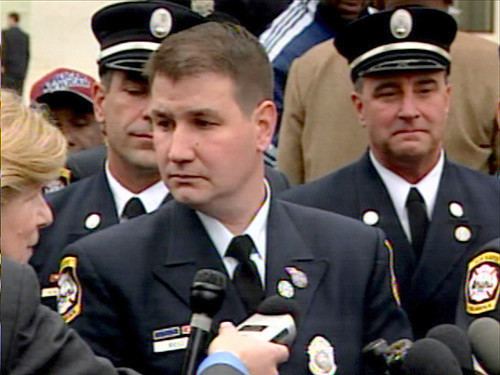 | ||
Full case name Frank Ricci, et al. v. John DeStefano, et al. Citations 557 U.S. 557 (more)129 S. Ct. 2658 Prior history Summary judgment for defendants, 554 F.Supp.2d 142 (D. Conn. 2006), aff'd, 264 Fed. Appx. 106 (2d Cir. 2008), summary order withdrawn, aff'd, 530 F.3d 87 (2d Cir. 2008), reh'g en banc denied, 530 F.3d 88(2d Cir. 2008), cert. granted, 555 U.S. ___ (2009). Majority Kennedy, joined by Roberts, Scalia, Thomas, Alito Similar Griggs v Duke Power Co, Parents Involved in Communi, Wards Cove Packing, City of Richmond v JA Cr, Grutter v Bollinger | ||
Ricci v destefano court of appeals oral argument
Ricci v. DeStefano, 557 U.S. 557 (2009) is a US labor law case of the United States Supreme Court on unlawful discrimination through disparate impact under the Civil Rights Act of 1964.
Contents
- Ricci v destefano court of appeals oral argument
- Acs presents ricci v destefano briefing highlights
- Facts
- Examinations
- Parties
- Claims
- District Court
- Second Circuit
- Supreme Court
- Concurrence
- Dissent
- Significance
- References
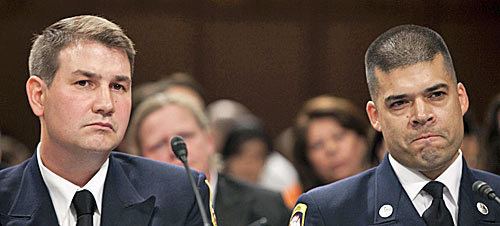
Eighteen city firefighters at the New Haven Fire Department, seventeen white and one Hispanic, claimed discrimination under Title VII of the Civil Rights Act of 1964 after they had passed the test for promotions to management positions and the city declined to promote them. New Haven officials invalidated the test results because none of the black firefighters scored high enough to be considered for the positions. City officials stated that they feared a lawsuit over the test's disproportionate exclusion of certain racial groups from promotion under "disparate impact" head of liability.
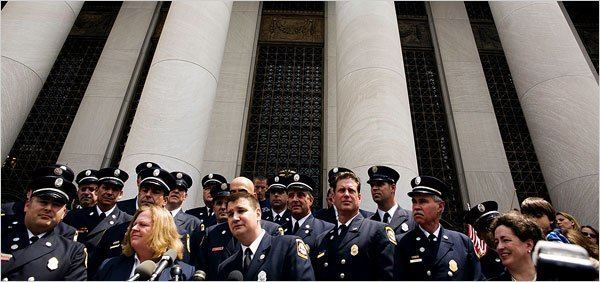
The Supreme Court held 5–4 that New Haven's decision to ignore the test results violated Title VII because the city did not have a "strong basis in evidence" that it would have subjected itself to disparate impact liability if it had promoted the white and Hispanic firefighters instead of the black firefighters. Because the plaintiffs won under their Title VII claim, the Court did not consider the plaintiffs' argument that New Haven violated the constitutional right to equal protection.

Acs presents ricci v destefano briefing highlights
Facts
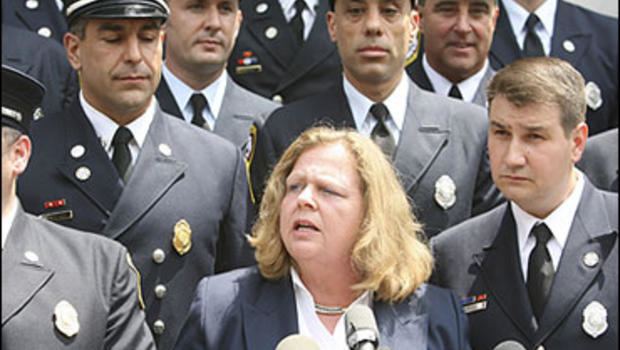
In late 2005, the New Haven Fire Department had seven openings for Captain and eight openings for Lieutenant. To fill the open positions, it needed to administer civil service examinations. The examinations consisted of two parts: a written examination and an oral examination.
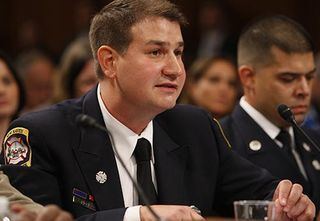
The examinations were governed in part by the City of New Haven's contract with the firefighters' union (which stated that the written exam result counted for 60% of an applicant's score and the oral exam for 40%, and that a total score above 70% on the exam would constitute a passing score). The final selection would be governed by a provision in the City Charter referred to as the "Rule of Three", which mandated that a civil service position be filled from among the three individuals with the highest scores on the exam.
Examinations
The New Haven Department of Human Resources issued an RFP for these examinations, as a result of which I/O Solutions ("IOS") designed the examinations. The examinations themselves were administered in November and December 2003; 118 firefighters took the examinations (77 took the Lieutenant exam and 41 took the Captain exam).
When the results came back, the pass rate for black candidates was approximately half that of the corresponding rate for white candidates:
Parties
Ricci and sixteen other white test takers, plus one Hispanic, all of whom would have qualified for consideration for the promotions, sued the city including Mayor John DeStefano, Jr. The lead plaintiff was Frank Ricci, who had been a firefighter at the New Haven station for 11 years. Ricci gave up a second job to have time to study for the test. Because he has dyslexia, he paid an acquaintance $1,000 to read his textbooks onto audiotapes. Ricci also made flashcards, took practice tests, worked with a study group, and participated in mock interviews. He placed 6th among 77 people who took the lieutenant's test; thus, under the "Rule of Three", Ricci would have been eligible for promotion.
Lt. Ben Vargas, the lone Hispanic petitioner, was allegedly attacked by unknown black assailants in Humphrey's East Restaurant in 2004 and had to be hospitalized afterwards. He has since stated that he believes the attack was orchestrated by the black firefighters in retribution for bringing in the legal case; his account is vigorously disputed by some critics. Vargas quit the Hispanic firefighters' association, which included Vargas's brother, after the group declined to support his legal case.
In addition to Ricci and Vargas, other firefighters were equally involved and were named plaintiffs: Steven Durand, Greg Boivin, Mark Vendetto, John Vendetto, Kevin Roxbee, James Kottage, Matthew Marcarelli, Edward Riordan, Sean Patten, Brian Jooss, Michael Christoforo, Timothy Scanlon, Ryan DiVito, Christopher Parker, Michael Blatchley, William Gambardella, Thomas Michaels, and Gary Carbone. The press dubbed the group the New Haven 20.
Claims
Among other things, the suit alleged that, by discarding the test results, the City and the named officials discriminated against the plaintiffs based on their race, in violation of both Title VII of the Civil Rights Act of 1964, 78 Stat. 253, as amended, 42 U. S. C. §2000e et seq., and the Equal Protection Clause of the Fourteenth Amendment to the United States Constitution. The City and the officials defended their actions, arguing that if they had certified the results, they could have faced liability under Title VII for adopting a practice that had a disparate impact on the minority firefighters.
District Court
Judge Janet Bond Arterton in the federal district court ruled for the city, granting its motion for summary judgment.
Second Circuit
On appeal, a three-judge panel of the Second Circuit Court of Appeals (Pooler, Sack and Sotomayor, C.JJ.) heard arguments in this case of discrimination. Judge Sotomayor (who was subsequently elevated to Associate Justice to the U.S. Supreme Court) vigorously questioned the attorneys in the case, and repeatedly discussed whether the city had a right to attempt to reformulate its test if it was afraid that the original test was discriminatory or that it would result in litigation. The three-judge panel then affirmed the district court's ruling in a summary order, without opinion, on February 15, 2008.
After a judge on the Second Circuit requested that the court hear the case en banc, however, the panel withdrew its summary order and on June 9, 2008 issued instead a unanimous per curiam opinion. The panel's June 9, 2008 per curiam opinion was eight sentences long. It characterized the trial court's decision as "thorough, thoughtful and well-reasoned" while also lamenting that there were "no good alternatives" in the case. The panel expressed sympathy with the plaintiffs' situation, particularly Ricci's, but ultimately concluded that the Civil Service Board was acting to "fulfill its obligations under Title VII [of the Civil Rights Act]." The panel concluded by adopting the trial court's opinion in its entirety.
A petition for a rehearing en banc was denied on June 12, 2008 by a vote of 7-6. Judge José Cabranes and Chief Judge Dennis Jacobs wrote opinions in dissent from the denial of rehearing, urging review by the Supreme Court.
The Supreme Court granted certiorari and heard oral arguments on April 22, 2009.
Supreme Court
Kennedy J for a 5–4 majority (joined Roberts CJ, Scalia J, Thomas J, and Alito J) held that the City violated the Civil Rights Act of 1964, Title VII by discarding the test scores. It failed to establish any "genuine dispute that the examinations were job-related and consistent with business necessity." In the majority's view, the employer should have "demonstrate[d] a strong basis in evidence that, had it not taken the action, it would have been liable under the disparate-impact statute."
The Supreme Court upheld the fairness and validity of the examinations that IOS developed and administered. IOS is an Illinois company that specializes in designing entry-level examinations and promotional examinations for fire and police departments; and other public safety and corporate organizations. The Court cited examples of how the IOS test design, criteria, and methodology included: interviews, observations, education, test format compliance, and independent assessors. With that information IOS produced a test that reduced adverse impact to the protected class.
Supreme Court Justice Anthony Kennedy wrote, “In order to fit the examinations to the New Haven Department, IOS began the test-design process by performing job analyses to identify the tasks, knowledge, skills, and abilities that are essential for the lieutenant and captain positions.”
The process that IOS used to design their test for the job analyses portion included interviews of incumbent captains and lieutenants and their supervisors, and ride-along observations of other on-duty officers. Using that information, IOS wrote job-analysis questionnaires and administered them to most of the incumbent battalion chiefs, captains, and lieutenants in the Department. ”
Kennedy J continued, "At every stage of the job analysis, IOS, by deliberate choice, over-sampled minority firefighters to ensure that the results which IOS would use to develop the examinations—would not intentionally favor white candidates."
Kennedy J included in the Opinion the following procedures IOS used to develop the written examinations to measure the candidates' job-related knowledge. “IOS compiled a list of training manuals, Department procedures, and other materials to use as sources for the test questions and received approval from the New Haven fire chief and assistant fire chief. Then, using the approved sources, IOS drafted a 100 question multiple-choice test written below a 10th-grade reading level. The City then opened a 3-month study period in which it gave candidates a list that identified the source material (or references list) for the questions, including the specific chapters from which the questions were taken.”
IOS also developed the oral examinations that concentrated on job skills and abilities. Using the job-analysis information, IOS wrote hypothetical situations to test incident-command skills, firefighting tactics, interpersonal skills, leadership, and management ability, among other things. Candidates were then asked these hypotheticals and had to respond to a panel of three assessors.
The Court agreed that IOS demonstrated due diligence by, “assembling a pool of 30 assessors who were superior in rank to the positions being tested. At the City's insistence (because of controversy surrounding previous examinations), all the assessors came from outside Connecticut. ”IOS submitted the assessors' resumes to City officials for approval. They were battalion chiefs, assistant chiefs, and fire chiefs from departments of similar sizes to New Haven's throughout the country. Sixty-six percent of the panelists were minorities, and each of the nine three-member assessment panels contained two minority members. They received training on how to score the candidates' responses consistently using checklists of desired criteria.
Section II-A reiterated the doctrines underlying a disparate-treatment claim.
First, Kennedy rejected arguments that the City did not discriminate. It engaged in "express, race-based decisionmaking" (i.e., disparate treatment/intentional discrimination) when it declined to certify the examination results because of the statistical disparity based on race — "i.e., how minority candidates had performed when compared to white candidates". The District Court was wrong to argue that respondents' "motivation to avoid making promotions based on a test with a racially disparate impact ... does not, as a matter of law, constitute discriminatory intent." "That argument turns upon the City's objective — avoiding disparate-impact liability — while ignoring the City's conduct in the name of reaching that objective."
Second, Kennedy examined the statutory framework of Title VII, to determine whether Title VII's proscription of disparate treatment is afforded any lawful justifications in the disparate impact provision that it seems to conflict with. Looking to analogous Equal Protection cases, he reached the statutory construction that, in instances of conflict between the disparate-treatment and disparate-impact provisions, permissible justifications for disparate treatment must be grounded in the strong-basis-in-evidence standard. He concluded that "once [a] process has been established and employers have made clear their selection criteria, they may not then invalidate the test results, thus upsetting an employee's legitimate expectation not to be judged on the basis of race. Doing so, absent a strong basis in evidence of an impermissible disparate impact, amounts to the sort of racial preference that Congress has disclaimed, §2000e–2(j), and is antithetical to the notion of a workplace where individuals are guaranteed equal opportunity regardless of race."
Next, Kennedy inquired whether the city's justifications for its disparate-treatment discrimination met this strong basis in evidence standard. He concluded that they did not: "Even if respondents were motivated as a subjective matter by a desire to avoid committing disparate-impact discrimination ... [t]here is no evidence — let alone the required strong basis in evidence — that the tests were flawed because they were not job-related or because other, equally valid and less discriminatory tests were available to the City. Fear of litigation alone cannot justify an employer's reliance on race to the detriment of individuals who passed the examinations and qualified for promotions."
The test results produced significant racial adverse impact, and confronted the City with a prima facie case of disparate-impact liability. That compelled them to "take a hard look at the examinations" to determine whether certifying the results would have had an impermissible disparate impact. The problem for respondents is that a prima facie case of disparate-impact liability — essentially, a threshold showing of a significant statistical disparity, and nothing more — is far from a strong basis in evidence that the City would have been liable under Title VII had it certified the results. That is because the City could be liable for disparate-impact discrimination only if the examinations were not job related and consistent with business necessity, or if there existed an equally valid, less-discriminatory alternative that served the City's needs but that the City refused to adopt. §2000e–2(k)(1)(A), (C). Neither condition holds:
- He found no genuine dispute that the examinations were job-related and consistent with business necessity. The City's assertions to the contrary are "blatantly contradicted by the record." (Section II-C-1)
- He found that respondents also lacked a strong basis in evidence of an equally valid, less-discriminatory testing alternative that the City, by certifying the examination results, would necessarily have refused to adopt. (Section II-C-2.)
He concluded: The record in this litigation documents a process that, at the outset, had the potential to produce a testing procedure that was true to the promise of Title VII: No individual should face workplace discrimination based on race. Respondents thought about promotion qualifications and relevant experience in neutral ways. They were careful to ensure broad racial participation in the design of the test itself and its administration. As we have discussed at length, the process was open and fair. The problem, of course, is that after the tests were completed, the raw racial results became the predominant rationale for the City's refusal to certify the results. The injury arises in part from the high, and justified, expectations of the candidates who had participated in the testing process on the terms the City had established for the promotional process. Many of the candidates had studied for months, at considerable personal and financial expense, and thus the injury caused by the City's reliance on raw racial statistics at the end of the process was all the more severe. Confronted with arguments both for and against certifying the test results — and threats of a lawsuit either way — the City was required to make a difficult inquiry. But its hearings produced no strong evidence of a disparate-impact violation, and the City was not entitled to disregard the tests based solely on the racial disparity in the results.
Our holding today clarifies how Title VII applies to resolve competing expectations under the disparate-treatment and disparate-impact provisions. If, after it certifies the test results, the City faces a disparate-impact suit, then in light of our holding today it should be clear that the City would avoid disparate-impact liability based on the strong basis in evidence that, had it not certified the results, it would have been subject to disparate-treatment liability.
Concurrence
Scalia J, though concurring in full, regretted that the Court declined to clarify the conflict between Title VII's disparate-impact provisions and the Constitution's guarantee of equal protection. Specifically: although the Court clarified that the disparate-treatment provisions forbid "remedial" race-based actions when a disparate-impact violation would not otherwise result, "it is clear that Title VII not only permits but affirmatively requires such [remedial race-based] actions" when such a violation would result. In the latter situations, Title VII's disparate-impact provisions "place a racial thumb on the scales, often requiring employers to evaluate the racial outcomes of their policies, and to make decisions based on (because of) those racial outcomes." "That type of racial decision making is, as the Court explains, discriminatory."
Dissent
Ginsburg J, joined by Stevens J, Souter J and Breyer J, dissented. They would have held that New Haven was entitled to not promote the white firefighters, and its concern of being open to litigation - whether or not accurate - was legitimate.
Significance
New Haven reinstated the examination results and promoted 14 of the 20 firefighters within months of the decision. The city settled the lawsuit by paying $2 million to the firefighter plaintiffs; each promotable-individual received 3 years of "service time" towards their pension; and paying their attorney, Karen Lee Torre, $3 million in fees and costs.
This case has been criticized by those who say that the decision did not account for other potential remedies' ineffectiveness, or was not called for based on the history of the case. One hypothesis is that the court was looking for a case that raised an issue having to do with racial discrimination, as it has before in Parents Involved in Community Schools v. Seattle School District No. 1 and Northwest Austin Municipal Utility District No. 1 v. Holder.
